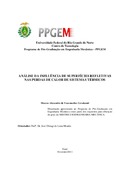Please use this identifier to cite or link to this item:
https://repositorio.ufrn.br/handle/123456789/15636| Title: | Análise da influência de superfícies refletivas nas perdas de calor de sistema térmicos |
| Authors: | Cavalcanti, Marcos Alexandre de Vasconcelos |
| Advisor: | Mendes, José Ubiragi de Lima |
| Keywords: | Superfícies refletivas;Isolante térmico;Aço inoxidável;Perdas de calor;Reflective surfaces;Thermal insulation;Stainless sdteel;Heat loss |
| Issue Date: | 28-Feb-2011 |
| Publisher: | Universidade Federal do Rio Grande do Norte |
| Citation: | CAVALCANTI, Marcos Alexandre de Vasconcelos. Análise da influência de superfícies refletivas nas perdas de calor de sistema térmicos. 2011. 83 f. Dissertação (Mestrado em Tecnologia de Materiais; Projetos Mecânicos; Termociências) - Universidade Federal do Rio Grande do Norte, Natal, 2011. |
| Portuguese Abstract: | O uso de superfícies refletivas funcionando como isolante térmico tem crescido de forma significativa nos últimos anos. Os isolantes térmicos reflexivos são materiais que possuem como características, baixa emissividade, baixa absortividade e elevada refletividade no espectro do infravermelho. A utilização desses materiais é uma alternativa que vem sendo incrementada a cada dia, uma vez que esse tipo de isolante tem propriedades radiantes importantes como forma de minimizar as perdas de calor em sistemas de aquecimento, como também em sistemas de climatização quando se tem como finalidade o bloqueio da passagem de calor em coberturas de edificações. Visando analisar a influência dessas superfícies refletivas como forma de reduzir a transferência de calor em sistemas onde se requer a conservação de energia, montou-se um sistema de paredes múltiplas de três superfícies de aço inoxidável 430 espelhado, espaçadas igualmente entre si e que funcionam como barreira radiante. A análise foi feita no sistema com e sem a presença de vácuo e comparados em seguida com análise feita utilizando a lã de vidro entre as mesmas, uma vez que este tipo de isolante além de ser considerado resistivo, é utilizado tradicionalmente no mundo em sistemas térmicos. Foram também medidas experimentalmente a refletividade e emissividade das placas utilizadas. Para a obtenção das medidas de temperatura das superfícies das chapas de aço inox, foi inserido um termopar tipo K fixado em cada superfície a fim de avaliar o comportamento térmico para cada configuração do sistema. Os resultados mostraram que, o uso de superfícies refletivas como uma forma de minimizar as perdas de calor em sistemas térmicos teve uma eficiência de 13%, no entanto, o sistema com presença de vácuo, foi o que obteve o melhor resultado, 60% de eficiência, ambos com relação à utilização de lã de vidro como isolante convencional |
| Abstract: | The use of reflective surfaces functioning as thermal insulator has grown significantly over the years. Reflective thermal insulator are materials that have several characteristics such as low emissivity, low absorptivity and high reflectivity in the infrared spectrum. The use of these materials has grown a lot lately, since it contains several important radioactive properties that minimize the heat loss of thermal systems and cooling systems that are used to block the heat on the roof of buildings. A system made of three surfaces of 316 stainless steel mirror was built to analyze the influence of reflective surfaces as a way to reduce the heat loss and thereby conserve the energy of a thermal system. The system was analyzed both with and without the presence of vacuum, and then compared with a system that contained glass wool between the stainless steel mirror walls, since this isolator is considered resistive and also broadly used around the world in thermal systems. The reflectivity and emissivity of the surfaces used were also measured in this experiment. A type K thermocouple was fixed on the wall of the system to obtain the temperature of the stainless steel mirror surfaces and to analyze the thermal behavior of each configuration used. The results showed an efficiency of 13% when the reflective surfaces were used to minimize the heat loss of the thermal system. However, the system with vacuum had the best outcome, a 60% efficiency. Both of these were compared to the system made of glass wool as a thermal insulator |
| URI: | https://repositorio.ufrn.br/jspui/handle/123456789/15636 |
| Appears in Collections: | PPGEM - Mestrado em Engenharia Mecânica |
Files in This Item:
| File | Description | Size | Format | |
|---|---|---|---|---|
| MarcosAVC_DISSERT.pdf | 898,71 kB | Adobe PDF |  View/Open |
Items in DSpace are protected by copyright, with all rights reserved, unless otherwise indicated.

